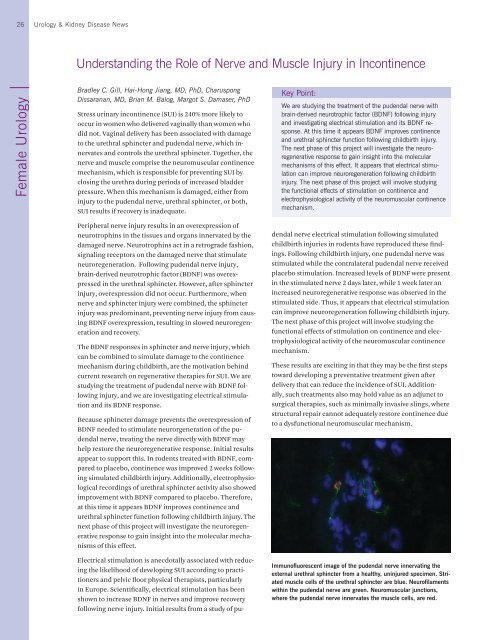Urology & Kidney Disease News - Cleveland Clinic
Urology & Kidney Disease News - Cleveland Clinic
Urology & Kidney Disease News - Cleveland Clinic
Create successful ePaper yourself
Turn your PDF publications into a flip-book with our unique Google optimized e-Paper software.
26 <strong>Urology</strong> & <strong>Kidney</strong> <strong>Disease</strong> <strong>News</strong><br />
Female <strong>Urology</strong><br />
Understanding the Role of Nerve and Muscle Injury in Incontinence<br />
Bradley C. Gill, Hai-Hong Jiang, MD, PhD, Charuspong<br />
Dissaranan, MD, Brian M. Balog, Margot S. Damaser, PhD<br />
Stress urinary incontinence (SUI) is 240% more likely to<br />
occur in women who delivered vaginally than women who<br />
did not. Vaginal delivery has been associated with damage<br />
to the urethral sphincter and pudendal nerve, which innervates<br />
and controls the urethral sphincter. Together, the<br />
nerve and muscle comprise the neuromuscular continence<br />
mechanism, which is responsible for preventing SUI by<br />
closing the urethra during periods of increased bladder<br />
pressure. When this mechanism is damaged, either from<br />
injury to the pudendal nerve, urethral sphincter, or both,<br />
SUI results if recovery is inadequate.<br />
Peripheral nerve injury results in an overexpression of<br />
neurotrophins in the tissues and organs innervated by the<br />
damaged nerve. Neurotrophins act in a retrograde fashion,<br />
signaling receptors on the damaged nerve that stimulate<br />
neuroregeneration. Following pudendal nerve injury,<br />
brain-derived neurotrophic factor (BDNF) was overexpressed<br />
in the urethral sphincter. However, after sphincter<br />
injury, overexpression did not occur. Furthermore, when<br />
nerve and sphincter injury were combined, the sphincter<br />
injury was predominant, preventing nerve injury from causing<br />
BDNF overexpression, resulting in slowed neuroregeneration<br />
and recovery.<br />
The BDNF responses in sphincter and nerve injury, which<br />
can be combined to simulate damage to the continence<br />
mechanism during childbirth, are the motivation behind<br />
current research on regenerative therapies for SUI. We are<br />
studying the treatment of pudendal nerve with BDNF following<br />
injury, and we are investigating electrical stimulation<br />
and its BDNF response.<br />
Because sphincter damage prevents the overexpression of<br />
BDNF needed to stimulate neurorgeneration of the pudendal<br />
nerve, treating the nerve directly with BDNF may<br />
help restore the neuroregenerative response. Initial results<br />
appear to support this. In rodents treated with BDNF, compared<br />
to placebo, continence was improved 2 weeks following<br />
simulated childbirth injury. Additionally, electrophysiological<br />
recordings of urethral sphincter activity also showed<br />
improvement with BDNF compared to placebo. Therefore,<br />
at this time it appears BDNF improves continence and<br />
urethral sphincter function following childbirth injury. The<br />
next phase of this project will investigate the neuroregenerative<br />
response to gain insight into the molecular mechanisms<br />
of this effect.<br />
Electrical stimulation is anecdotally associated with reducing<br />
the likelihood of developing SUI according to practitioners<br />
and pelvic floor physical therapists, particularly<br />
in Europe. Scientifically, electrical stimulation has been<br />
shown to increase BDNF in nerves and improve recovery<br />
following nerve injury. Initial results from a study of pu-<br />
Key Point:<br />
We are studying the treatment of the pudendal nerve with<br />
brain-derived neurotrophic factor (BDNF) following injury<br />
and investigating electrical stimulation and its BDNF response.<br />
At this time it appears BDNF improves continence<br />
and urethral sphincter function following childbirth injury.<br />
The next phase of this project will investigate the neuroregenerative<br />
response to gain insight into the molecular<br />
mechanisms of this effect. It appears that electrical stimulation<br />
can improve neuroregeneration following childbirth<br />
injury. The next phase of this project will involve studying<br />
the functional effects of stimulation on continence and<br />
electrophysiological activity of the neuromuscular continence<br />
mechanism.<br />
dendal nerve electrical stimulation following simulated<br />
childbirth injuries in rodents have reproduced these findings.<br />
Following childbirth injury, one pudendal nerve was<br />
stimulated while the contralateral pudendal nerve received<br />
placebo stimulation. Increased levels of BDNF were present<br />
in the stimulated nerve 2 days later, while 1 week later an<br />
increased neuroregenerative response was observed in the<br />
stimulated side. Thus, it appears that electrical stimulation<br />
can improve neuroregeneration following childbirth injury.<br />
The next phase of this project will involve studying the<br />
functional effects of stimulation on continence and electrophysiological<br />
activity of the neuromuscular continence<br />
mechanism.<br />
These results are exciting in that they may be the first steps<br />
toward developing a preventative treatment given after<br />
delivery that can reduce the incidence of SUI. Additionally,<br />
such treatments also may hold value as an adjunct to<br />
surgical therapies, such as minimally invasive slings, where<br />
structural repair cannot adequately restore continence due<br />
to a dysfunctional neuromuscular mechanism.<br />
Immunofluorescent image of the pudendal nerve innervating the<br />
external urethral sphincter from a healthy, uninjured specimen. Striated<br />
muscle cells of the urethral sphincter are blue. Neurofilaments<br />
within the pudendal nerve are green. Neuromuscular junctions,<br />
where the pudendal nerve innervates the muscle cells, are red.

















